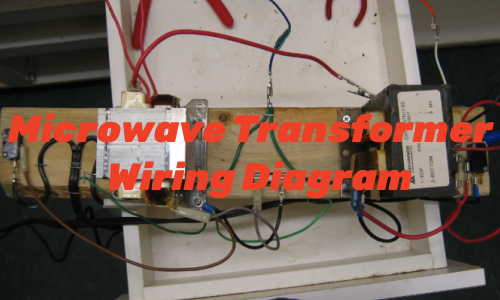OUTLINE:
Decoding the Language of Microwave Transformer Wiring Diagrams
 1023
1023Microwave transformers are crucial components that convert high voltage electricity to the appropriate levels needed to power microwave ovens. Understanding the diagrams can help diagnose issues, perform repairs, or even modifying some aspects of your microwave's functionality. This article will equip you with the knowledge to properly wire a microwave transformer.

What Is a Microwave Transformer Wiring Diagram
It is a detailed schematic showing the specific connections between the various components within a microwave oven, with the transformer being the central focus.
Here are some key points to remember about microwave transformer wiring diagrams:
- Types of Diagrams: There are different types of diagrams for different microwave models and brands. Some may be simplified schematics focusing on the transformer connections, while others might be more complex, encompassing the entire electrical circuit.
- Components Represented: The diagram will typically show the transformer itself, along with other components like the magnetron, high-voltage capacitor, diode, and various switches and controls.
- Color Coding: Wires are often represented by different colors in the diagram to indicate their function and voltage level. This helps in tracing the connection paths and understanding the relationships between components.
- Safety Symbols: Pay attention to any safety symbols, warnings, or notes included in the diagram. These could indicate specific hazards or precautions to be taken while working with the components.
The Components Of The Diagrams
Understanding the key components depicted on these diagrams is crucial for navigating them effectively. Here's a breakdown of the essential elements you'll likely encounter.
1. Transformer:
- The star of the show! It's usually represented by a rectangle with multiple windings labeled in different colors. These windings indicate the primary (low voltage) and secondary (high voltage) sides of the transformer.
- Different transformer types (high voltage, filament) might have variations in their diagram representation.
2. Magnetron:
- This heart of the microwave generates the high-voltage radio waves responsible for heating food. It's typically depicted as a cylinder with connections to the high-voltage capacitor and transformer secondary winding.
3. High-Voltage Capacitor:
- Stores electrical charge used by the magnetron. It might appear as a cylinder or rectangular symbol with voltage markings.
4. Diode:
- Allows current to flow in one direction, directing the high voltage pulse to the magnetron. It's often shown as a triangle with an arrow indicating the direction of current flow.
5. Switches and Controls:
- Various switches and controls like door interlock, timer, and power switches are represented by symbols depicting their functionality. Identifying these allows you to trace their connection to the transformer and understand their impact on the circuit.
6. Wiring:
- Different colored lines represent wires with varying functions and voltage levels. Understanding the color code specific to your diagram is crucial for tracing connections and troubleshooting issues.
7. Grounding Symbol:
- A horizontal line with vertical bars indicates the grounding point, crucial for safety and preventing electrical shocks.
8. Additional Components:
- Depending on the diagram complexity, you might encounter symbols for fuses, transformers for powering control circuits, and other components specific to your microwave model.

The Uses Of Microwave Transformer Wiring Diagrams
Microwave transformer wiring diagrams offer a valuable tool for various purposes, but always remember to prioritize safety and seek professional help if you're unsure about any aspect of working with high-voltage equipment.
Troubleshooting and Repair:
- Identifying Faulty Components: The diagram helps pinpoint potential sources of malfunctions by tracing connections and analyzing voltage levels.
- Repairing Component Failures: Diagrams guide the replacement of faulty components like the diode, capacitor, or even the transformer itself.
- Understanding Error Codes: Some diagrams can be linked to specific error codes displayed on your microwave, revealing the affected component and suggesting repair strategies.
Modification and Upgrade:
- Adding Features: Experienced enthusiasts might use diagrams to understand circuit connections and attempt adding functionalities like a turntable or light bulb.
- Boosting Power Output: Advanced users might carefully modify specific connections to adjust the magnetron's power output (not recommended).
Educational Purposes:
- Learning Electronics: Diagrams serve as visual aids for understanding the relationships between components and the principles of microwave operation.
- Developing Repair Skills: For qualified technicians, mastering diagrams is crucial for diagnosing and repairing various microwave models.
Remember:
- Safety First: High voltage inside microwaves poses serious risks. Only qualified professionals should handle repairs involving the transformer or other high-voltage components.
- Match the Diagram: Use diagrams specific to your microwave model and brand for accurate information and avoid potential harm from mismatched connections.
- Seek Professional Help: When in doubt, consult a qualified repair technician for safe and reliable troubleshooting or modifications.
Conclusion
A microwave transformer wiring diagram offer a valuable window into the complex inner workings of many appliances. However, it's crucial to approach them with caution due to the high voltage and potential dangers involved in working with microwave components. Always prioritize safety if you're unsure about any aspect of the wiring or repair process.

Disclaimer: The views and opinions expressed by individual authors or forum participants on this website do not represent the views and opinions of Chipsmall, nor do they represent Chipsmall's official policy.

share this blog to:

